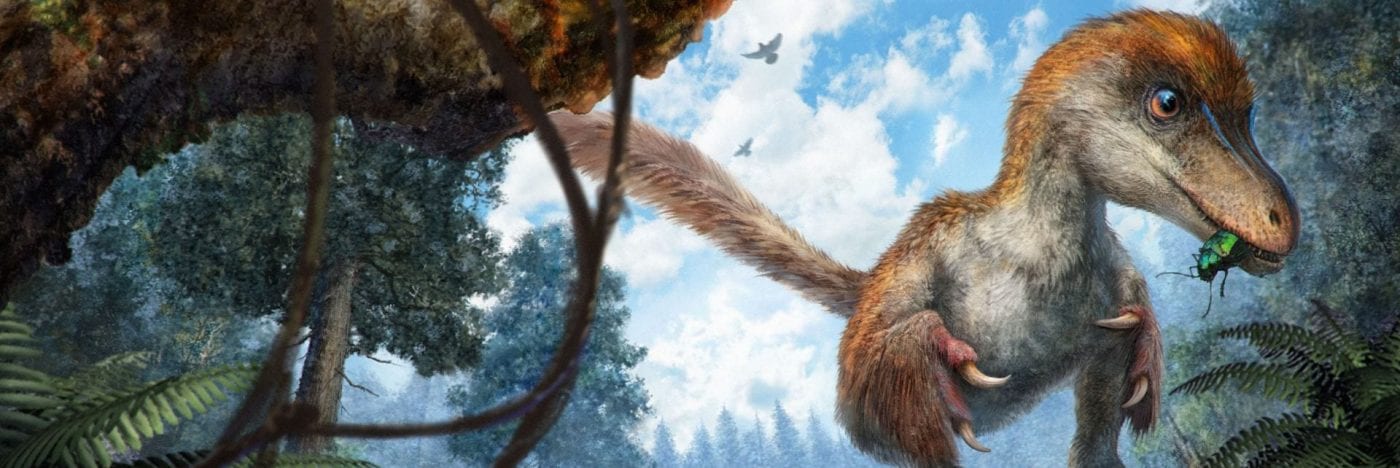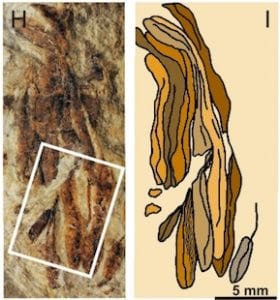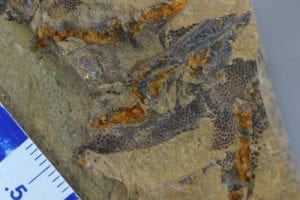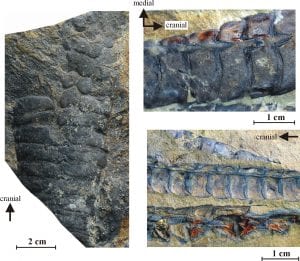Surely ornithischian dinosaurs did not have feathers?
 At one time, palaeontologists would have thought it was ridiculous to imagine that any dinosaurs had feathers. Then feathers were identified in more and more theropod dinosaurs – but at least these theropods were close to the origin of birds. When it was reported that the ornithischian Psittacosaurus sported a fence of quills along the top of its tail (Mayr et al. 2002), it was widely suggested that these were not feathers, but something else altogether.
At one time, palaeontologists would have thought it was ridiculous to imagine that any dinosaurs had feathers. Then feathers were identified in more and more theropod dinosaurs – but at least these theropods were close to the origin of birds. When it was reported that the ornithischian Psittacosaurus sported a fence of quills along the top of its tail (Mayr et al. 2002), it was widely suggested that these were not feathers, but something else altogether.
Then, feather-like structures were reported in the heterodontosaurid ornithischian Tianyulong (Zheng et al. 2009), which also sported bristles along its back. When these specimens were published, it became a little more likely that feathers might have been more widespread among dinosaurs than anyone had suspected.
[Right] Drawings of a model of Psittacosaurus made by Bob Nicholls (Palaeocreations, Bristol).
New studies of the Psittacosaurus bristles showed there were 100 cylindrical bristles along the midline of its tail, each up to 160 mm long (Mayr et al. 2016). By examining the bristles under fluorescent light, the researchers noted a central pulp cavity that widens towards the bristle base. They suggested the Psittacosaurus bristles were not simply feathers, but were more robust because of extra layers of keratin and probably analogous to the cornified spine on the head of the horned screamer, a kind of duck, or the ‘beard’ of the turkey and the crown of the Congo peafowl. These extra-tough structures in modern birds do not develop from follicles in the skin, as regular feathers do, and it may be that Psittacosaurus, and perhaps Tianyulong, had specially cornified bristles that are related developmentally to feathers, but are not true feathers. Close study of excellently preserved specimens of Psittacosaurus (Vinther et al. 2016) do not reveal feathers elsewhere on the body, but simply a covering of scales, and that it showed countershading, indicating a life in forests.
The debate about whether ornithischians had feathers or not was resolved for many with the report (Godefroit et al. 2014) of a third ornithischian dinosaur with featherss. The new ornithopod was reported from the Middle Jurassic of Siberia, in eastern Russia, and named Kulindadromeus baikalicus, meaning ‘Kulinda runner from the Zabaikal region’, as it comes from a site called Kulinda on the banks of the Olov River, in Zabaikal District, in Siberia. Kulindadromeus shows epidermal scales on its tail and shins, and short bristles on its head and back. The most astonishing discovery, however, is that it also has complex, compound feathers associated with its arms and legs. In fact, Kulindadromeus shows three types of scales and three types of feathers.
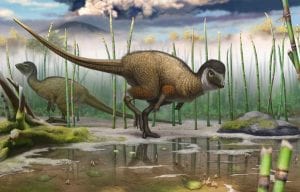
[Left] Kulindadromeus zabaikalicus in its lacustrine environment. Painting by Andrey Atuchin.
Kulindadromeus was a small plant-eater, only about 1m long. It had long hind legs and short arms, with five strong fingers. Its snout was short, and its teeth show clear adaptations to plant eating. In evolutionary terms, it sits low in the evolutionary tree of ornithischian dinosaurs. There are six skulls and several hundred partial skeletons of this new dinosaur at the Kulinda locality
The Kulinda site was found in summer 2010 by Professor Sofia Sinitsa from the Institute of Natural Resources, Ecology and Cryology SB RAS in Chita, Russia. In 2013, the Russian-Belgian team excavated many dinosaur fossils, as well as plant and insect fossils.
Kulindadromeus feathers and scales
The specimens are notable for the excellent preservation of feathers and scales. There are three types of feathers, (1) monofilaments (‘hairs’) around the head and trunk areas, measuring 1-3 cm long; (2) compound structures in which bunches of 6 to 7 filaments, each 10-15 mm long, attach to a basal plate, and located around the humerus and femur; and (3) ribbonlike structures, each up to 3 mm wide and 20 mm long and composed of about ten filaments.
There are also three types of scales: (1) tiny, nonoverlapping scales, 1 mm across, around the hand and foot; (2) larger, hexagonal scales, 3.5 mm across, on the shins; and (3) five longitudinal rows of slightly arched scales (~20 mm long and 10 mm wide) along the proximal part of the tail, overlapping each other.
The mix of feathers and scales shows that both could coexist, just as in modern birds – chickens for example have scaly legs, and vultures and turkeys have scaly patches over their necks and heads. Developmental experiments in modern chickens suggest that bird scales are aborted feathers, an idea that explains why birds have scaly legs. Perhaps the molecular mechanisms needed for this switch already existed in Kulindadromeus.
This discovery suggests that feather-like structures were likely widespread in dinosaurs, possibly even in the earliest members of the group. Feathers probably arose during the Triassic, more than 220 million years ago, for purposes of insulation and signalling, and were only later co-opted for flight. Smaller dinosaurs were probably covered in feathers, mostly with colourful patterns, and feathers may have been lost as dinosaurs grew up and became larger.
Feather loss is not surprising; it would have been analogous to the loss of hair in large mammals such as elephants, rhinos, and whales. Developmentally, feather production in bird skin is the norm, and it has to be suppressed by secondary genomic ‘switches’ to keep the legs or neck clear of feathers. Likewise in mammals, we lack hair on the palms of our hands and soles of our feet, as well as on our eyeballs and in our mouths because of genes that suppress hair formation.
Preservation of the Kulinda feathers
The Kulinda dinosaur bones are associated with abundant, well preserved fossils of plants, insect larvae, and freshwater crustaceans that suggest deposition in a low-energy, likely lacustrine, fresh-water environment. Probably Kulindadromeus fed on the plants that are found with it, including conifers, seed ferns, and horsetails. The dinosaur bones are not in the form of complete skeletons, which indicates that the bones have been transported by rivers, but not far, because some elements are associated, such as bones of an arm or leg, and the skin, bearing scales and feathers, is close to the relevant bones.
The feathers and scales are preserved as carbon-rich films on the rock. These show three types of scales on the lower legs and along the tail, and three types of feather-like structures. The carbon within the feathers and scales appears to have survived (but not necessarily the original biomolecules such as proteins), and so the fine detail of the scales and feathers is preserved with high fidelity.
Normally hair, scales, and feathers disappear during fossilization. This usually happens very early in the long road from the dead animal to the fossil. After the dinosaur died, its carcass would have been picked over by scavengers, including flesh-eating dinosaurs, and perhaps some early mammals, as well as insects. These might well remove all flesh from the bones over a week or so. In the case of the Kulinda dinosaurs, their carcasses did not undergo this scavenging phase, but they were probably washed away by a river and dumped on a slow-moving stretch, perhaps at a bend in the river. They were rapidly covered with muddy sand, and, together with plant and other debris, quickly buried. The mud seems to be still rich in organic matter, so this suggests that there was not a great deal of oxygen in these river-bottom sediments, and the whole site might have been black and sulphurous, so inhibiting further decay.
A nice report of the find, with many images taken in the field at Kulinda can be read here.
References
- Godefroit, P., Sinitsa, S.M., Dhouailly, D., Bolotsky, Y.L., Sizov, A.V., McNamara, M.E., Benton, M.J., and Spagna, P. 2014. A Jurassic ornithischian dinosaur from Siberia with both feathers and scales. Science 345, 451-455. pdf. Supplementary file.
- Mayr, G., Peters, D.S., Plodowski, G., and Vogel, O. 2002. Bristle-like integumentary structures at the tail of the horned dinosaur Psittacosaurus. Naturwissenschaften 89, 361-365.
- Mayr, G., Pittman, M., Saitta, E., Kaye, T.G. and Vinther, J. 2016. Structure and homology of Psittacosaurus tail bristles. Palaeontology 59, 793–802.
- Vinther, J., Nicholls, R., Lautenschlager, S., Pittman, M., Kaye, T. G., Rayfield, E., Mayr, G. and Cuthill, I. C. 2016. 3D camouflage in an ornithischian dinosaur. Current Biology 26, 2456–2462.
- Zheng, X.-T., You, H.-L., Xu, X., and Dong, Z.-M. 2009. An Early Cretaceous heterodontosaurid dinosaur with filamentous integumentary structures. Nature 458, 333-336.
